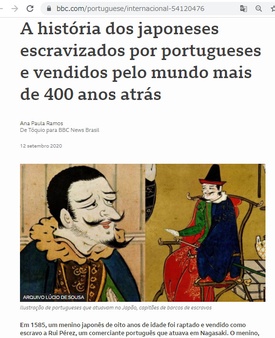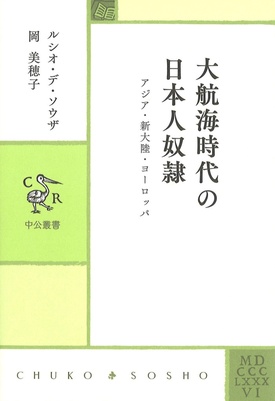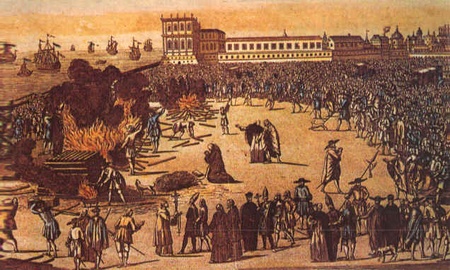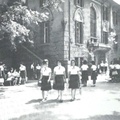
A sensational article ran on BBC Brazil.
The article is in Portuguese and is titled " The History of Japanese Slaves Sold Around the World by the Portuguese 400 Years Ago " (September 12th, by Ana Paula Ramos). It was based on an interview with Associate Professor Lucio de Souza of Tokyo University of Foreign Studies and Associate Professor Mihoko Oka of the Historiographical Institute of the University of Tokyo.
The book begins with the words, "In 1585, an eight-year-old Japanese boy was kidnapped and sold as a slave to the Portuguese merchant Rui Pérez. Born in Bungo Province (present-day Oita City, Oita Prefecture), the boy was one of the first five Asian slaves acquired by Pérez and became known as 'Gaspar Fernández.'"
It also states, "According to researchers, the boy was abducted by the Japanese, who at the time did a common practice of kidnapping and selling people to the Portuguese. Galpar stayed with the Pérez family and worked as a domestic servant. He learned Portuguese and Spanish, and was taken with the family to Manila in the Philippines, where Pérez was punished for secretly practicing Judaism, which was banned. The merchant was taken to Mexico, put on trial for heresy, and died two days before arriving in Acapulco."
Associate Professor Souza told a BBC reporter about his feelings at finding the document, saying: "After a month of research in Mexico, spending several hours a day studying the slaves' archives, I finally got my hands on it. I knew that this was not just a document, I was dealing with the real life of a man who had been exploited and forgotten."
Is it possible that Japanese slaves came to the country in the 16th century?
Many readers may remember the serial article " Understanding the Mystery of Japanese Slaves: Did They Land in South America 400 Years Ago? " that ran in this newspaper in April 2009. The article was also republished with significant additions and corrections in "Immigrants and the Japanese" (Mumeisha Publishing), which I published in Japan last year.
In 1596, in Cordoba, Argentina, a young Japanese man named Francisco Japón was sold as a slave by Diego Lopez to Father Miguel Jerónimo de Porras for 800 pesos, but documents have been discovered in which the young Japanese man filed a lawsuit claiming that he was not a slave.
Ever since writing the series, Columnko has raised the possibility that "some of the Japanese slaves brought to Portugal later made their way to Brazil," and "Japanese people such as Francisco Japón from Argentina may have been transported to Brazil by Portuguese merchants."
However, the main text of the BBC article states, "Brazil, which needed manual laborers and had been colonized by the Portuguese since the beginning of the same century, had Asian slaves primarily used for domestic work. In Lisbon, many families showed off their Japanese slaves as 'imports.'"
In other words, Associate Professor Lucio may think that it is impossible for Japanese slaves to come to Brazil because "Brazil brought in black slaves as farm laborers, and Portugal brought in Japanese slaves as domestic laborers."
The "oldest record of a Japanese person living in Lisbon" mentioned in the BBC article is a document showing the marriage of a Japanese female slave, Jacinta de Sá Brandao, to a Japanese male slave, Guilherme Brandao, at the Church of Conceição in 1573.

In 2017, Associate Professor Souza and his colleagues published "Japanese Slaves in the Age of Discovery" (Chuko Publishing Co., Ltd.), which details the results of their research. It is a very rare and valuable book.
There has been little serious research on Japanese slavery, with only rumors and fragmentary anecdotes being presented. As the topic has a strong impression of being the "dark side of Japanese history," it may have been difficult for orthodox researchers to get involved. However, it is truly a blessing that a Portuguese researcher living in Japan has tackled this difficult topic head-on. This research is truly valuable.
New Christians and the Age of Discovery
In "Japanese Slaves in the Age of Discovery," Associate Professor Souza writes that through his meticulous research, he found historical documents in the records of the Portuguese Inquisition that show three Japanese slaves traveling to Mexico. It seems that there were quite a few hidden Jews among the Portuguese merchants who owned Japanese slaves.
Jews are generally called "New Christians" (cristãos novos). The Iberian Peninsula, where Spain and Portugal are located, was conquered by Islamic forces that invaded from Africa in the 8th century, and Christian countries continued the movement to reconquer it, known as the Reconquista, and finally recaptured it in the 15th century.
Therefore, to distinguish them from the "old Christians" (Portuguese: cristãos velhos), the Jews and Moors (Muslims of northwestern Africa) who converted to Catholicism after the Reconquista came to be called "New Christians." They are sometimes simply called "conversos" (converts).

Among these Jews were many "crypto Jews" who pretended to have converted, and those suspected of being heretics were subjected to the "Inquisition."
The Wikipedia article on "New Christians" (accessed October 17th) states, "After their conversion, New Christians adopted their baptismal names and abandoned their Hebrew or Arabic names. There were quite a few New Christians (or people considered to be New Christians) among the traders and missionaries protected by the Kingdom of Portugal and the Kingdom of Spain. They were active during the Age of Discovery, and some were the spearhead of overseas colonization by Spain and Portugal, while others, such as Las Casas, denounced the inhuman treatment of the indigenous people by the colonizers and invading forces. Some of them brought Nanban culture to Japan."
In other words, "hidden Jews" who found it difficult to live in Portugal and Spain themselves became active as merchants on ships during the Age of Discovery.
*This article is reprinted from the Nikkei Shimbun (October 20, 2020).
© 2020 Masayuki Fukasawa / Nikkey Shimbun





